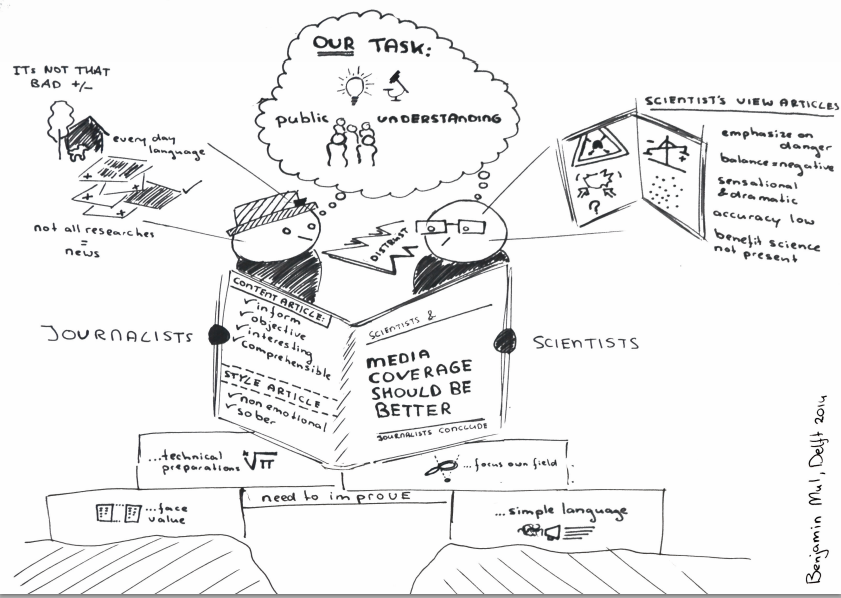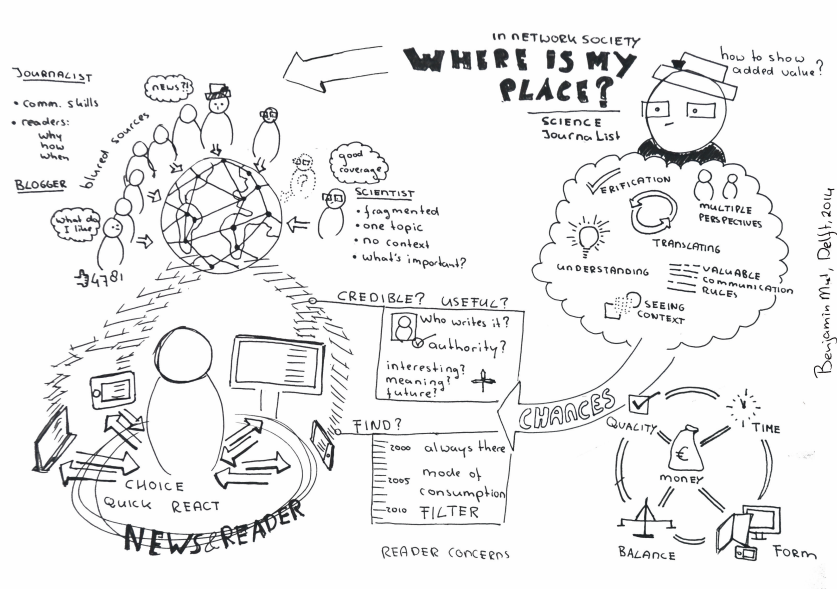A Science Journalist’s Chances
Frank Nuijens, @FrankNu on Twitter, recently pinged me in a tweet featuring an infographic that one of his Masters of Science Communication students created after reading my EMBO Reports article on the future of science journalism, An Explosion of Alternatives. Intrigued, I got in touch with the student, Benjamin Mul, to ask if he could talk to me about his graphics, shown below.

Frank is a science journalist and founder of ScienceOnline Leiden, the Dutch community of people communicating about science on the web. He is also a lecturer in science journalism at Delft University of Technology, where Benjamin is earning his Masters degree.
"I set for myself the goal this half year to communicate more visually," Benjamin says. For this particular assignment, he first read The Media and Public Understanding of Biotechnology: A Survey of Scientists and Journalists by Gunter (1999). He then read my own article, An Explosion of Alternatives: Considering the Future of Science Journalism.
"After I started drawing it became quickly clear that is was a good choice to do so," Benjamin says. "Both articles contained a lot of different information. To get a grip on the insights, I always want to see the relations [between them] so I understand what the context is and how things relate to each other. When I know that, I can reproduce it and reflect on it. I experienced that during [this] drawing ... my own view on the situation came into the drawing. So the drawings are not just summaries, but [reflect] how I dealt with the information. The best example is the whole idea of 'chances' instead of problems [in science journalism]. Especially from your article, I saw a lot of chances for a science journalist in the current situation."
As Benjamin reflects from my article in EMBO Reports, modern science journalism is often blurring the lines between journalist, blogger, scientist and reader. As information online explodes, the journalist (or blogger) must take on the disparate tasks of data collection, curation, explanation, contextualization, investigation, and visualization. Demands placed on the science journalist include looking at multiple perspectives, verifying data, understanding and translating science. The science journalist or blogger must also be able to see what the public is interested in, and provide news about science that is new but not too far from what readers already know or are interested in. When readers find science journalists or bloggers who do this successfully, they are rewarded by good and credible information filtered according to their interests and uses.
For the science journalist, however, and especially the science blogger, the difficult task remains earning money. Part of this, in Benjamin's view, is the science journalist's or blogger's ability to determine how he or she can add value in covering science in a chosen medium.
From my own research this summer (#MySciBlog project), I would say adding value from a personal perspective, whether based on lived experiences or scientific expertise, is almost a shared obsession among science bloggers. But it is by far and large a GOOD obsession - it has lead readers, journalists and scientists alike to take blogs seriously as sources of information not easily found elsewhere.
"For a science journalist it is hard to show his added value," Benjamin says. "He/she needs to find good balance between quality, speed of publishing, money, good balance in articles and the right media forms. Important is the knowledge a science journalist has about communication and forms. It enables him to see why traditional [media] rules exist, and how he can play with form and ways of publishing. So there are a lot of chances for a science journalist. I hope that others will be inspired by my drawing and start experimenting themselves."
A Science Journalist’s Chances
By Benjamin Mul (with edits by Paige Brown Jarreau)
While interacting with science, I, the science journalist, have the chance to…
... help the scientist interact with the public. I can also help make the science more understandable to the lay public. I can challenge the scientist to place the topic in the context of the reader and ask him/her to explain it as if he/she was telling it to his/her children. Communicating may not be his/her expertise. But an expert should be able to explain what he/she is doing.
...share quotes and use facts when possible. Also sharing and discussing an article can clear the air between both scientist and journalist. Questions about benefits, pros and cons should be a part of the conversation(s). I don’t know if it is possible, but it could be interesting to create a kind of network or alliance of scientists in writing an article.
[Editor's Note: Perhaps a form of collaborative science journalism? Might group science blogs approach this idea?]
...always check the credibility of data (e.g. fact-check) to avoid tunnel vision. It can be one of the elements that distinguishes me from others. Finding balance between quality, time, money and form may be difficult, but quality needs to be taken seriously.
...write in everyday language. To achieve that, I might ask the expert about applications, metaphors and simple words. Next to that, good interview preparation is important so that I will be able to ask informed questions. ‘Is it like…?’ It can also help to know my target audience beforehand. This should make it easier to link the science to their lives.
...experiment with new formats. An example could be a long-lived interactive news page. Or using images, infographics and movies instead of written text. A lot of science journalists are accustomed to print media, especially written. But (a lot of) words are often not the best way to share information via online platforms. This assignment is an experiment in using visuals to communicate science.
The last one is not an insight but a motivation: science is always changing, nothing is definitive. Often it will have implications on the short or long term on people’s life.

